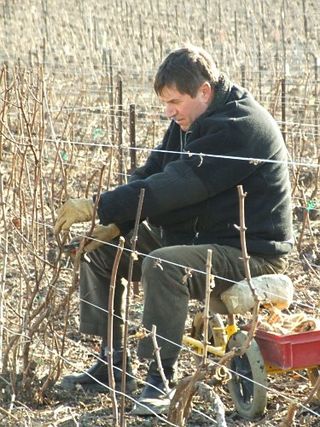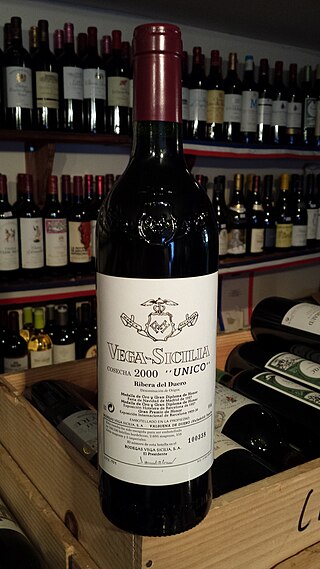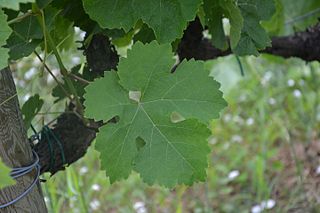
Bordeaux is a city on the river Garonne in the Gironde department, southwestern France. A port city, it is the capital of the Nouvelle-Aquitaine region, as well as the prefecture of the Gironde department. Its inhabitants are called "Bordelais" (masculine) or "Bordelaises" (feminine). The term "Bordelais" may also refer to the city and its surrounding region.

Cabernet Sauvignon is one of the world's most widely recognized red wine grape varieties. It is grown in nearly every major wine producing country among a diverse spectrum of climates from Australia and British Columbia, Canada to Lebanon's Beqaa Valley. Cabernet Sauvignon became internationally recognized through its prominence in Bordeaux wines, where it is often blended with Merlot and Cabernet Franc. From France and Spain, the grape spread across Europe and to the New World where it found new homes in places like California's Napa Valley, New Zealand's Hawke's Bay, South Africa's Stellenbosch region, Australia's Margaret River, McLaren Vale and Coonawarra regions, and Chile's Maipo Valley and Colchagua. For most of the 20th century, it was the world's most widely planted premium red-wine grape until it was surpassed by Merlot in the 1990s. However, by 2015, Cabernet Sauvignon had once again become the most widely planted wine grape, with a total of 341,000 hectares (3,410 km2) under vine worldwide.

Sauvignon blanc is a green-skinned grape variety that originates from the city of Bordeaux in France. The grape most likely gets its name from the French words sauvage ("wild") and blanc ("white") due to its early origins as an indigenous grape in South West France. It is possibly a descendant of Savagnin. Sauvignon blanc is planted in many of the world's wine regions, producing a crisp, dry, and refreshing white varietal wine. The grape is also a component of the famous dessert wines from Sauternes and Barsac. Sauvignon blanc is widely cultivated in France, Chile, Romania, Canada, Australia, New Zealand, South Africa, Bulgaria, the states of Oregon, Washington, and California in the US. Some New World Sauvignon blancs, particularly from California, may also be called "Fumé Blanc", a marketing term coined by Robert Mondavi in reference to Pouilly-Fumé.

Oak is used in winemaking to vary the color, flavor, tannin profile and texture of wine. It can be introduced in the form of a barrel during the fermentation or aging periods, or as free-floating chips or staves added to wine fermented in a vessel like stainless steel. Oak barrels can impart other qualities to wine through evaporation and low level exposure to oxygen.

Pauillac is a municipality in the Gironde department in Nouvelle-Aquitaine in southwestern France. The city is mid-way between Bordeaux and the Pointe de Grave, along the Gironde, the largest estuary in western Europe.

A winemaker or vintner is a person engaged in winemaking. They are generally employed by wineries or wine companies, where their work includes:

Bordeaux wine is produced in the Bordeaux region of southwest France, around the city of Bordeaux, on the Garonne River. To the north of the city, the Dordogne River joins the Garonne forming the broad estuary called the Gironde; the Gironde department, with a total vineyard area of 110,800 hectares, is the second largest wine-growing area in France behind the Languedoc-Rousillon.

Bodegas Vega Sicilia is a Spanish winery located in the Ribera del Duero Denominación de Origen in the Province of Valladolid, Castile and León. The winery was founded in 1864 by Don Eloy Lecanda y Chaves, who planted various grapes from the Bordeaux wine region of France, including Cabernet Sauvignon and Merlot, which are still being used in the wines today.
Château Lascombes is a winery in the Margaux appellation of the Bordeaux region of France. The wine produced here was classified as one of fifteen Seconds Crus in the original Bordeaux Wine Official Classification of 1855. In the 1950s, the estate was purchased by French wine writer Alexis Lichine who continued to own part of the estate till 1971 when Bass Charrington took over principal ownership. In 2001 it was purchased by Yves Vatelot and US-based Colony Capital, who in 2011 sold it to the French insurance group MACSF. In addition to its premier cuvee, a second wine is also produced, under the name Chevalier de Lascombes. Additional brands are Château Segonnes, Rosé de Lascombes, Vin Sec Chevalier de Lascombes and Gombaud.
Wine lake is a cultural phrase referring to the phenomenon of perceived overproduction of wine in the European Union. The phenomenon first came in perception & persistence around the mid-1980s and reemerged in the mid-2000s as a significant issue. The EU's Common Agricultural Policy contained a number of subsidies for wine producers, leading to a supply glut. This surplus forced an overhaul of EU farm policies.

The Australian wine industry is one of the world's largest exporters of wine, with approximately 800 million out of the 1.2 to 1.3 billion litres produced annually exported to overseas markets. The wine industry is a significant contributor to the Australian economy through production, employment, export, and tourism.
Christian Delpeuch is president emeritus of the French Conseil Interprofessionel du Vin de Bordeaux (CIVB). He won support for Plan Bordeaux, an effort to save the wine industry of Bordeaux. The plan calls for growers to reduce yields, decrease total area of vineyards, divert excess wine into production of ethanol fuels and cleaning solutions, reclassify lesser vineyards as vin de pays, and start putting varietal names on wine labels.

Racking, often referred to as Soutirage or Soutirage traditionnel, also filtering or fining, is the process of moving wine or beer from one container to another using gravity rather than a pump, which can be disruptive to the beverage. The process is also known as Abstich in German and travaso in Italian.
Château Pichon Longueville Comtesse de Lalande is a winery in the Pauillac appellation of the Bordeaux region of France. Château Pichon Longueville Comtesse de Lalande is also the name of the red wine produced by this property. The wine produced here was classified as one of fifteen Deuxièmes Crus in the original Bordeaux Wine Official Classification of 1855.
David Peppercorn is a British Master of Wine, French wine importer and author, known for his books about the wines of Bordeaux and long experience in his field, having collected tasting notes since the late 1950s. He is married to fellow MW and wine writer Serena Sutcliffe. They were the first husband and wife team to both earn the qualification of Master of Wine. He has three daughters by a previous marriage. Peppercorn's books include Bordeaux, The Wines of Bordeaux, The Simon & Schuster Pocket Guide to the Wines of Bordeaux, Mouton-Rothschild 1945, The Wine To End All Wars and Great Vineyards and Winemakers.

Gringet is an autochthonous white wine grape from Haute-Savoie, France that is used as both a blending grape and for varietal wines. It is mainly used in the Ayze AOC sparkling wine production. The wine grape grown on the hills above the lower Vallee de l'Arve, in the French Alps (Haute-Savoie).
A Ningxia wine is any wine produced in the Chinese province of Ningxia. Since large producers moved into the region in the 1980s and local producer successes at wine competitions in the 2010s spurred further development, Ningxia has become one of the premier wine regions in China.

Denis Dubourdieu was a French winemaker and professor of oenology at the University of Bordeaux. He managed or co-managed several properties in Bordeaux, including Château Reynon, Château Doisy Daëne, Château Cantegril, Château Haura, and Clos Floridène. He also consulted at Château Cheval Blanc and 4G Wines.












